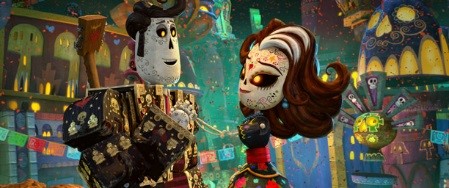Now Showing: The Book of Life
November 5, 2014
While most people above the age of eight easily dismiss the slew of cookie-cutter computer animated children’s movies regularly released in theaters, “The Book of Life” breaks through the typical PG mold.
Director Jorge Gutierrez presents his take on the Mexican holiday, the Day of the Dead, which involves the celebration and remembrance of dead ancestors, in a way viewers can enjoy. Through the voice of a museum tour guide, a story is told of La Muerte, the beautiful ruler of the Land of the Remembered, and Xibalba, the evil ruler of the Land of the Forgotten. The two gods come to a disagreement on the Day of the Dead, eventually forming a wager. They place bets on two young boys, Manolo and Joaquín, best friends who are both in love with the same girl, Maria. La Muerte chooses Manolo, betting that he will marry Maria, and Xibalba chooses Joaquín.
The rest of the film follows the love triangle of the three friends, with some interferences from Xibalba and Maria’s father. Manolo, voiced by Diego Luna, grows up to be a sensitive and passionate musician, who would rather sing than carry on his family tradition of bull fighting. Joaquín, voiced by Channing Tatum, becomes a courageous soldier, the town hero with a dark secret, who vows to protect all from the evil bandit Chakal. Both vie for the heart of Maria, voiced by Zoe Saldana, who is free-spirited and values compassion over strength.
While the movie’s cliché plot is nowhere near award-winning, the vibrant animation makes up for its flaws. The one-of-a-kind visual style entrances audiences. Characters are made of wood, like puppets, and swim in a sea of rich colors and unusual patterns. No two characters look the same; all have very distinctive features, specifically noses, which is alarming at first.
Unlike other children movies, “The Book of Life” is entertaining to older audience members as well. Many adult jokes are made, some poking fun at Mexican culture and tradition, but never crossing the line of inappropriateness. The film also features many popular songs, the majority of them sung by Manolo, who belts out his versions of “Creep” by Radiohead and “I Will Wait” by Mumford and Sons, with his own Mexican flair.
Another aspect of the film that is surprising is its character development. With the creative animation, screenwriters could have easily forgone the emotional growth of the main characters. Joaquín, who is shown from the beginning of the film as a courageous young fighter, becomes overpowered by the fame he’s received as the town hero. He believes that he can win over Maria with his muscles and medals, both of which she has no interest in. At first this rejection flusters him, but, by the end of the film, he realizes that he was wrong in valuing brawn over brains, and is willing to accept Maria’s decision.
Because the film revolves around the Day of the Dead, many of the characters in the movie face the end of their lives, and the beginning of their eternity in the Land of the Remembered, which is portrayed as a place better than Earth. Death is an unusual topic for a children’s movie, especially in such a positive context. But Gutierrez presents his own adaption of the Mexican folklore, making it fun for every audience member, even those who aren’t familiar with that world.




